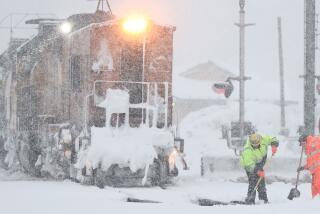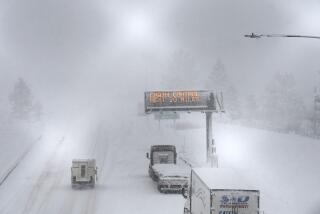Rare Snowfall Creates Huge Traffic Jams
- Share via
Snow fell across Southern California on Wednesday, from the oceanfront hillsides of Malibu to the desert canyons at Palm Springs. The blustery Arctic storm forced schools to close, sealed off mountain highways and created mammoth traffic jams throughout the Los Angeles Basin.
Scores of storm-related traffic accidents were reported, at least one of which claimed a life. More than 10,000 customers lost electrical power, about 8,000 of them in the Rialto area of San Bernardino County.
Snow was still falling in some of the mountain passes late Wednesday night, and California Highway Patrol officials said the state’s main north-south artery--Interstate 5--probably would not be reopened before late today.
Other major highways through the mountains were opened for traffic--at least partially--by Wednesday afternoon, but CHP officials said the storm might again force the closure of passes during the night.
The rare snowfall produced wondrous vistas and unexpected difficulties for natives and tourists alike.
Laurie Ames, 33, a visitor from Toronto who found herself stuck in the traffic backed up by the heavy snow on Cajon Pass, said she had come to the Southland with “visions of orange trees, sunshine and heat. . . .
“My visions of sunny California are shot,” she said.
Forecasters said snow should fall sporadically in scattered foothill areas this morning, with totals of more than a foot expected at mountain resort levels. Rain showers were expected at lower elevations throughout today.
The snow that fell early Wednesday morning did not stick long in Malibu and Palm Springs, but as much as five inches piled up in Westlake, Porter Ranch, Calabasas, Simi Valley and Tarzana before beginning to melt.
In Granada Hills, children grabbed cardboard boxes and trash can lids to slide down the hillsides denuded in last December’s devastating brush fires.
“It was all black and ugly and horrible,” said Mary Ellen Crosby, who lives in Granada Hills. “Now its all white and glistening and beautiful,”
Steve Pina stood shivering in a sweat suit at his home in Porter Ranch, trying to scrape the ice from his car’s windshield with his bare hands.
“I don’t even know how to do this,” he finally admitted.
Officials in the Santa Clarita Valley said the community was “basically sealed off” at mid-morning by three to five inches of snow.
“Our schools are closed--everything’s closed,” said Robert Norlemann, a deputy sheriff at the Santa Clarita station. “When people call in, we tell them to take the day off.”
Officials said more than 20,000 students missed classes in the Santa Clarita area, and thousands more had the day off in the snowy Antelope Valley, although no school officials were present to provide precise figures.
Hazardous driving conditions around half a dozen schools in the northern reaches of the San Fernando Valley prompted advisories for children who had not already left for school to stay at home.
Pupils already on buses headed for the six schools--Frost Junior High and Castle Bay Lane, Knollwood, El Oro Way, Van Gogh and Hubbard elementary schools--were rerouted to Francis Polytechnic High School in North Hollywood.
The flurries that briefly dusted the beaches at Malibu and the golf courses at Palm Springs did little for their images as havens from the wintry weather Back East. By noon, temperatures in both communities were well above freezing, but a little snow still stuck to hillsides above the towns.
Snow Piled on Cars
“When I woke up it was snowing and the cars were piled up with about an inch of snow,” said Phoebe Paros, a 9-year-old student at Webster Elementary School in Malibu who lives with her family in Latigo Canyon. “I tried to make a snowman, but it melted.”
The principal highways into the Southland from the north and east--Interstate 5 over the Tejon Pass, California 14 between Newhall and Palmdale, I-15 over the Cajon Pass and I-10 through San Gorgonio Pass--were all closed by snow and ice by midnight Tuesday.
I-15 reopened at 3:30 p.m. Wednesday, but cars had to be escorted by the CHP; delays of several hours were reported. I-10 reopened at 2 p.m. and traffic was reported moving slowly in both directions.
As for I-5, CHP Officer Bob Jones said Wednesday afternoon that “we’re (still) talking major snow out there” and the highway through the Tejon Pass probably would not reopen until 24 hours after the major force of the storm has passed.
The CHP said icy conditions temporarily shut down California 118 at the Santa Susana Pass, between the San Fernando and Simi valleys, and California 126, between Fillmore and I-5. Roads to most mountain resort areas were impassable without chains.
‘You Won’t Believe This’
Jerry Gambino, waiting patiently with crowds of others at a restaurant in Ontario while snowplows labored to clear a path on I-15 through the mountains, said he called his wife in St. Louis, Mo., at about 10 a.m. to explain the delay.
“I told her, ‘Baby, you won’t believe this, but there’s a blizzard on Cajon Pass and I’ve been waiting since 4:30 (a.m.) to get through,’ ” he said. “She laughed and said, ‘Well, it’s been sunny here for two days.’ ”
Scores of motorists were stranded before dawn on I-5 and California 14 when their cars and trucks bogged down in the snow. The CHP eventually closed the on-ramps to both freeways, creating logjams of traffic that backed up for miles.
The trial of Night Stalker murder suspect Richard Ramirez was delayed Wednesday when a juror was turned back because of road conditions as he attempted to commute from Saugus to downtown Los Angeles.
Caltrans officials said they had at least 50 snowplows working in the Southland with more on the way from areas not hard hit by the storm. They said the delays in clearing the highways were due to the continuing snowfall, not to a shortage of equipment or personnel.
More than 40 traffic alerts were issued throughout the Los Angeles area during the morning rush hour as cars spun, skidded and caromed on pavement made slick by ice, snow and rain.
“It’s chaotic, the worst I’ve seen in years,” said Officer Ernie Garcia, a spokesman for the main CHP dispatch center in Los Angeles. “People are even driving the wrong way on the freeways, trying to avoid the closures. . . . There are traffic jams everywhere. It’s a mess.”
A 35-year-old Riverside man was killed when his speeding car slammed into the back of a slow-moving truck during a downpour on I-10 in the Redlands area, the CHP said. The man’s identity was withheld pending notification of relatives.
Rick Dittmann, a meteorologist with WeatherData Inc., which provides forecasts for The Times, said the icy storm was the product of three weather systems.
He said one of these is a high-pressure weather mass, part of the cold wave that has swept south from Alaska, setting low temperature records throughout the nation. This high-pressure mass was centered over the Great Basin Wednesday afternoon.
The other systems are two moist, Pacific-bred low-pressure masses that have moved inland across the coast, one into Northern California and the other into Central California. Reinforcing one another, these two systems are bringing large amounts of precipitation to much of California, although not as much to Southern California as originally expected.
Dittmann said that because these moist systems are colliding with the extremely cold air from the Alaskan front, snow has been falling at unusually low altitudes.
Official snowfall totals were not immediately available, but unofficial estimates placed storm totals of up to 10 inches in the Antelope Valley and well over a foot at higher mountain areas.
A total of .14 of an inch of rain had fallen at the Los Angeles Civic Center by Wednesday night, raising the season’s total to 6.49 inches. That’s still more than an inch less than last year’s 7.73 inches, and considerably below the normal seasonal total for Feb. 8 of 9.05 inches.
High of 51 Downtown
Other rainfall totals from the current storm by Wednesday evening included .65 inches at Woodland Hills; .51 at Santa Barbara; .18 at San Bernardino and .17 inches at Los Angeles International Airport.
The high temperature downtown Wednesday was just 51 degrees, the coldest maximum reading for the date on record. The old Feb. 8 record was 52 degrees, set in 1895. Tuesday’s top reading of 53 also broke the old record for that date by one degree, set on Feb. 7, 1949.
The storm Wednesday was the second to strike the Southland in less than a week. Last Saturday a storm dropped several inches of rain in the Los Angeles Basin and nearly a foot of snow in nearby mountains.
Times staff writers Stephanie Chavez, Denise Hamilton, Amy Pyle and Ginger Thompson contributed to this article.
SLOW GOING
Because of the continuing storm, highway travel from Southern California to the north remains uncertain this morning.
Interstate 5 through Tejon Pass: Expected to remain closed by snow until late this afternoon, at the earliest.
Interstate 15 through Cajon Pass: Subject to closures because of continuing snow. Delays expected.
California 14 between Newhall and the Antelope Valley: Subject to closures because of continuing snow. Delays expected.
U.S. 101: Congestion expected because of additional traffic from other routes and heavy weather north of San Luis Obispo.
Local mountain roads: Chains required at higher elevations. Delays expected.
More to Read
Sign up for Essential California
The most important California stories and recommendations in your inbox every morning.
You may occasionally receive promotional content from the Los Angeles Times.













